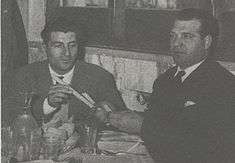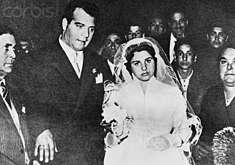Pasquale Simonetti
Pasquale Simonetti (Italian pronunciation: [paˈskwaːle simoˈnetti]; February 26, 1926 – July 16, 1955), known as Pascalone 'e Nola ("big Pasquale from Nola"), was an Italian criminal of the Camorra, a Mafia-type organisation in Naples and Campania in Italy.
Pasquale Simonetti | |
|---|---|
 Camorra boss Pasquale Simonetti | |
| Born | February 26, 1926 |
| Died | July 16, 1955 (aged 29) |
| Nationality | Italian |
| Other names | Pascalone 'e Nola |
| Allegiance | Camorra |
Early life and career
He was born in a poor family in Palma Campania, a town located at the foot of the Vesuvius in the hinterland of Naples about 25 km east of the city. His father was a carter and his mother was a housewife. His criminal career started in the 1940s falsifying ration books for food which he then sold on the black market.[1]
Subsequently, he entered the lucrative control over the fruit and vegetable business in Naples. In the early 1950s the Camorra controlled the entire chain of the fruit and vegetable markets. They imposed themselves as the protectors of the peasant farmers and shopkeepers, demanding in exchange the right to fix the price of products and control the business.[2] They set whatever price they wanted and were called ‘the Presidents of prices’.[3]
Emerging Camorra boss

This type of mediation racket developed in the immediate post-war period. Weak modern market structures were regulated by violent mediators who imposed their own business rules. Farmers who did not accept the conditions would be threatened or their farm would go up in flames. Bigger companies like Cirio, a large tinned tomatoes company in Campania, also fell victim to these practices. It was very complicated, if not impossible, to collect sufficient evidence to prove the criminal aspect of this business.[3] He became a partner of Antonio Esposito, known as Totonno 'e Pomigliano, a Camorra boss from Pomigliano d'Arco.[2]
Simonetti became one of the emerging bosses of the Camorra. He was a real guappo, a tall and strong man with a robust physique. An imposing criminal with great charisma, he used this advantage and became a kind of lawgiver in his area. To a certain extent he was an alternative to the State authorities which were barely present.[1] Some of his fellow citizens turned to him to ask for justice. A typical episode was the intimidation of a man who had made his girlfriend pregnant and then left her. Simonetti asked the young man, if he preferred spending hundred thousand lire in flowers on his marriage or his funeral.[4]
He is often mentioned as the one who slapped the notorious American gangster Lucky Luciano in the face at the race track of Agnano. However, in fact the perpetrator was Francesco Pirozzi, known as Ciccillo 'o francese, one of the men of Camorra boss Alfredo Maisto.[1][4]
Cigarette smuggling
After World War II the Italian government reintroduced a state monopoly on tobacco. However, the increasing post-war demand for cigarettes could not be satisfied by the state industry. The vast supplies of American and British troops stationed in Naples provided for a black market of popular American cigarettes, the americane or bionde (blondes). When the Allies left in 1946 that supply disappeared and the government was forced to ration cigarettes. Soon a thriving trade smuggling cigarettes from Marseille, Gibraltar, Nice and Tangiers by highly organised and structured foreign criminal groups (the Marseillais, Corsicans, Sicilians) developed, employing local guappi to distribute the cigarettes.[5]
Some of the more ambitious ones, like Simonetti and Maisto, became more involved. The competition was stiff and resulted in a number of armed conflicts with rival crews. In 1953 Simonetti was imprisoned for 8 years and 3 months for the attempted murder and a shoot-out over territorial supremacy against a rival gang led by Alfredo Maisto in 1952.[1][2][6]
Wedding

At Christmas 1954, Simonetti left prison, after serving two years of his sentence. On 27 April 1955 he married Assunta Maresca, known as Pupetta (Little Doll), a former beauty queen. The wedding was like a fairy tale with 500 guests, a lot of food and even his rivals Maisto and Esposito. The whole town of Palma Campania turned out to wish them well. Many gave them the traditional envelopes stuffed with money.[1][7]
Although his criminal activities slowed down under the influence of his young wife, he sought to regain his lost prestige and activities. While in prison, his partner Antonio Esposito had taken over his businesses. He had promised to keep a percentage of the profits for Simonetti, but he did not keep his promise. Jealousy and fierce competition grew with "both believing that they ruled over the market district of Il Vasto" resulting in a violent war between the two.[1]
Death
On July 16, 1955, Simonetti was murdered in broad day light in the Piazza Mercato, the busy market place of Naples. He was shot by Carlo Gaetano Orlando, a hitman commissioned by his rival Antonio Esposito.[8] In the time, the public prosecution hypothesized that the murder had been commissioned by the cousins of Gaetano Orlando, the Nuvoletta family, in those years engaged in the fruit and vegetable sector, and rivals in business of Pascalone 'e Nola.[9] The six months pregnant Pupetta was devastated. She believed the police knew who the man behind the attack was, but were not prepared to do anything about it. On August 4, 1955, she drove to Naples with her younger brother, Ciro. When they met Esposito, she reached into her handbag and pulled out a Smith & Wesson .38. Holding it with both hands ("I was afraid I would miss," she explained later), she opened fire and killed Esposito in broad daylight.[6][7][10]
On October 14, 1955, she was arrested. The trial started in April 1959 at the Court of Assizes in Naples.[2] The killing and the following trial made international headlines. At the trial, she defiantly declared: "I would do it again!" and the whole courtroom bursted into cheers.[11] She was sentenced to 18 years’ imprisonment, later reduced to 13 years and 4 months by the Court of Appeal.[2] Orlando was sentenced to 30 years.[6]
Simonetti’s son Pasqualino was born in prison. In 1974, he was abducted and murdered. His death remains a mystery, but Maresca believed the assailant was Umberto Ammaturo, her new companion, who denied knowing anything about his death.[12][13]
In popular culture
The life of Pasquale Simonetti and Pupetta Maresca inspired the film La sfida (The Challenge) (1958), by Francesco Rosi with José Suárez as Simonetti and Rosanna Schiaffino as Maresca.[14]
References
- Allum, The Neapolitan Camorra, pp. 142–45
- Pupetta Maresca Archived 2012-09-30 at the Wayback Machine, Criminology Museum Rome
- Allum, The Neapolitan Camorra, pp. 209–10
- (in Italian) "Pascalone 'e Nola", website dedicated to the memory of Pasquale Simonetti
- Allum, The Neapolitan Camorra, pp. 212–13
- (in German) Die Artischocken-Diktatur, Der Spiegel, May 27, 1959
- Fiandaca, Women and the Mafia, p. 12
- "Campania, i 10 criminali più pericolosi della camorra: ecco chi sono". L'Occhio (in Italian). 2019-05-07. Retrieved 2019-11-25.
- "Napoli, è morta la vedova di Tanino 'e Bastimento, il killer del guappo Pascalone 'e Nola". www.ilmattino.it (in Italian). Retrieved 2019-11-25.
- La Legge d'Onore, Time Magazine, April 20, 1959
- 'Crimes Of Honor' Debated By Italy; Trial of Woman in Naples for Murder of Husband's Rival Stirs Nation, The New York Times, April 7, 1959
- Longrigg, Mafia Women, pp. 1–10
- Fiandaca, Women and the Mafia, p. 14
- Una Donna, la Camorra e Napoli. Reccontati dal cinema e dalla stampa, dissertation, July 2007
- Allum, Felia Skyle (2000), The Neapolitan Camorra: Crime and politics in post-war Naples (1950-92), Brunel University
- Fiandaca, Giovanni (ed.) (2007), Women and the Mafia: Female Roles in Organized Crime Structures, New York: Springer ISBN 0-387-36537-0
- Longrigg, Clare (1998). Mafia Women, London: Vintage ISBN 0-09-959171-5
External links
- (in Italian) "Pascalone 'e Nola"